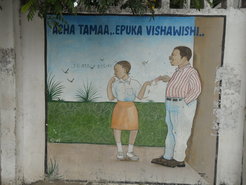Urban Intimacy in Eastern and Central Africa in the 20th Century
Stephanie Lämmert
This research project investigates urban eastern and central Africa as a hub for African women on the move who were seeking freedom. In the early 20th century, in the colonial copper towns of central Africa as well as in eastern Africa, rapid urbanization took place. As the mining industry grew on the central African Copperbelt and the eastern African coastal towns turned into colonial business and administrative centers, migrant laborers from the entire region flocked to the new towns. While the jobs on offer were hardly designed for women and their presence in town was discouraged by the colonial state, countless women came to the towns anyway, married and unmarried; the former group were following their husbands, while the latter included those who were not seeking the bond of marriage but looking for something else. Town life offered a number of new freedoms to women, such as being the head of one’s own household, business opportunities, wage labor (if limited), and formal education, but also new forms of leisure, pleasure, and romance. The Swahili saying kutafuta maisha, to search for the life, is an apt expression of what motivated African women to settle in towns.
How have these modern women, also referred to as femmes libres or champions, been depicted by male and female contemporaries since the 1920s? In which ways was the image of the modern woman intertwined with the discourse of romantic love, companionate marriage, and Christian respectability? What kinds of emotions are revealed through the (often male) gaze on urban women? And what were women supposed to feel, particularly those who resisted meeting the expectations set by respectability? In a close reading of “sugar stories,” I have traced the changing mores of female respectability in town society. The agency and leverage that town women involved with so-called sugar daddies had, as represented in popular youth magazines, changed with the deepening of the public health crisis and the consequences of structural adjustment. However, the ambivalence in fantasies about sugar relationships demonstrates the importance of emotions for understanding gendered and generational dynamics of social hierarchies and racial politics.
The project focuses on Northern Rhodesia/Zambia, the Belgian Congo/Katanga/the DR Congo, and Tanganyika/Tanzania in the period between the 1920s and 1990s. My sources consist of mission, government, and mining company publications and archives, as well as court records and oral interviews.
Key References

